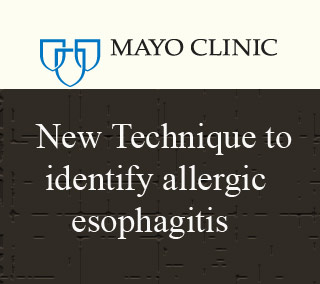
Eosinophilic esophagitis (EoE) also called as allergic esophagitis is noted to be an inflammatory condition in which the walls of the esophagus are filled with eosinophils. EoE was usually caused by an allergic reaction, however it may cause swallowing and other problems leading to painful, impacted food constricture in the esophagus.
James J. Lee, Ph.D., the Mayo Clinic biologist who led the team that developed the new diagnostic test and who, with his wife, Nancy A. Lee, Ph. D., has been pioneering eosinophil research at Mayo Clinic for 16 years, reveals “For the vast majority of cases, the diagnosis will now be faster, easier and hopefully more reliable. Moreover, this new strategy can be conducted without specialized equipment.â€
It was initially detected in the late 1980s and since then it’s been increasing. It was estimated that approximately more than 300,000 Americans go through this chronic condition. In addition, males and about one-fifth of children in contrast to females suffer from this disease.
Senior author of a study, Dr. Lee has stated that, “Together with our Mayo Clinic clinical colleagues (Drs. Lucinda Harris, Tisha Lunsford and Shabana Pasha), a Mayo Clinic pathologist (Dr. Giovanni DePetris), as well as Dr. Glenn Furuta from The Children’s Hospital in Denver, this collective group created the needed synergy to propel basic research activities to the forefront of patient care.â€
It was observed that till date, EoE appears to be unclear in some situations thus often preventing noticeable diagnosis. Allegedly, it is very important to diagnose the disease through medically examining the patients, together with assessments of symptoms and changes in the esophagus. Accordingly, symptoms like trouble swallowing, impacted food, heartburn and certain structural defects of the esophagus could be signs of EoE.
Unfortunately, many of these symptoms also seem to be common in conditions like gastro esophageal reflux disease (GERD). This increases the chances of mistaking it for GERD, thus extending the severity and uneasiness in patients, consequently diminishing his quality of life.
Supposedly, physicians found that EoE patients appear to have a high number of rare white blood cells which was associated to allergic reactions. These cells, however were absent in healthy subjects. In spite of this characteristic, the rare white blood cells were also found in GERD patients and in some situations they were hard to recognize. Due to this reason, gastroenterologists and pathologists while treating patients mainly children may call for several endoscopic tests and biopsies.
The Mayo Clinic and the Children’s Hospital team were believed to have developed a solution to this problem. They produced an antibody which particularly identifies a protein called eosinophil peroxidase (EPX). This protein was released by eosinophils situated inside the esophagus of patients.
With the help of this novel tool, the team developed a staining technique that could be utilized on existing tissue samples, as well as a unique scoring system with which evaluation of each patient could be done.
An estimate of 60 patients which includes adults from Mayo Clinic and pediatric patients from The Children’s Hospital were given the EPX antibody in order to examine the collected tissue samples. Experts could confirm the strength of this new strategy only through evaluating these results with diagnoses presently using available guidelines. As a result, the findings of the study point at the test’s exclusive ability to identify patients that have escaped diagnosis by traditional methods.
Dr Lee is hopeful that this study may perhaps signify an essential initial step but will have to go through a confirmation process before it can be adopted universally. This study should soon present Mayo Clinic physicians a new tool which they didn’t have previously for the care of their patients.
This study has been published in Clinical Gastroenterology and Hepatology.
